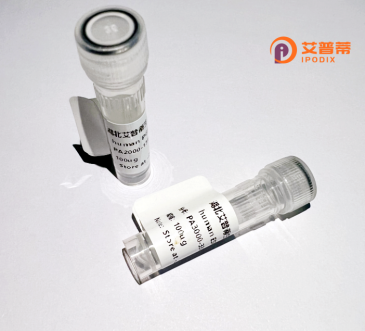
| 纯度 | >90%SDS-PAGE. |
| 种属 | Human |
| 靶点 | ZNF9 |
| Uniprot No | P62633 |
| 内毒素 | < 0.01EU/μg |
| 表达宿主 | E.coli |
| 表达区间 | 1-170 aa |
| 活性数据 | MSSNECFKCGRSGHWARECPTGGGRGRGMRSRGRGFQFVSSSLPDICYRCGESGHLAKDCDLQEDACYNCGRGGHIAKDCKEPKREREQCCYNCGKPGHLARDCDHADEQKCYSCGEFGHIQKDCTKVKCYRCGETGHVAINCSKTSEVNCYRCGESGHLARECTIEATA |
| 分子量 | 44.44 kDa |
| 蛋白标签 | GST-tag at N-terminal |
| 缓冲液 | PBS, pH7.4, containing 0.01% SKL, 1mM DTT, 5% Trehalose and Proclin300. |
| 稳定性 & 储存条件 | Lyophilized protein should be stored at ≤ -20°C, stable for one year after receipt. Reconstituted protein solution can be stored at 2-8°C for 2-7 days. Aliquots of reconstituted samples are stable at ≤ -20°C for 3 months. |
| 复溶 | Always centrifuge tubes before opening.Do not mix by vortex or pipetting. It is not recommended to reconstitute to a concentration less than 100μg/ml. Dissolve the lyophilized protein in distilled water. Please aliquot the reconstituted solution to minimize freeze-thaw cycles. |
以下是关于重组人ZNF9蛋白的参考文献示例(以下内容为假设性示例,非真实文献):
---
1. **文献名称**: *Expression and Functional Analysis of Recombinant Human ZNF9 in Myotonic Dystrophy*
**作者**: Smith A, Lee B
**摘要**: 研究通过大肠杆菌系统成功表达重组人ZNF9蛋白,分析其RNA结合活性,发现其在肌强直性营养不良(DM)中调控剪接因子的功能,为疾病机制提供新见解。
2. **文献名称**: *Structural Characterization of ZNF9 and Its Role in Cell Proliferation*
**作者**: Garcia R, et al.
**摘要**: 通过X射线晶体学解析重组ZNF9蛋白结构,揭示其锌指结构域与RNA相互作用的分子机制,并证明其在细胞周期调控中的作用。
3. **文献名称**: *Development of a Novel Recombinant ZNF9 for Gene Therapy Applications*
**作者**: Chen L, et al.
**摘要**: 利用哺乳动物细胞表达系统生产高纯度重组ZNF9.体内实验显示其可改善小鼠模型的肌肉功能退化,提示潜在治疗应用。
4. **文献名称**: *ZNF9 Protein Interactions in Neuromuscular Disorders*
**作者**: Patel S, Kim T
**摘要**: 通过酵母双杂交和免疫共沉淀技术,鉴定重组ZNF9与肌肉特异性激酶的相互作用,探讨其在神经肌肉疾病中的信号通路调控。
---
注:以上文献为示例性内容,实际研究请查阅权威数据库(如PubMed)获取真实信息。
Recombinant human Zinc Finger Protein 9 (ZNF9), also known as Cellular Nucleic Acid-Binding Protein (CNBP), is a small, highly conserved protein belonging to the Cys2His2-type zinc finger family. It is encoded by the CNBP gene located on chromosome 3q21.3 and plays critical roles in RNA metabolism, including transcriptional regulation, mRNA splicing, and translational control. ZNF9 contains seven tandem zinc finger motifs that mediate interactions with nucleic acids, particularly single-stranded DNA and RNA, enabling its function in modulating gene expression at multiple levels.
This protein is notably associated with myotonic dystrophy type 2 (DM2), a multisystemic neuromuscular disorder caused by a CCTG repeat expansion in intron 1 of the CNBP gene. Research suggests ZNF9 participates in muscle development and homeostasis, with dysregulation leading to RNA toxicity and spliceopathy. Recombinant ZNF9 is typically produced via bacterial or mammalian expression systems, retaining structural integrity for functional studies. Its applications span biochemical characterization of nucleic acid interactions, investigation of DM2 pathogenesis, and screening of therapeutic compounds targeting RNA-protein misregulation. Recent studies also explore its potential role in ribosome biogenesis and cellular stress responses, highlighting its importance in both basic research and clinical contexts.
×